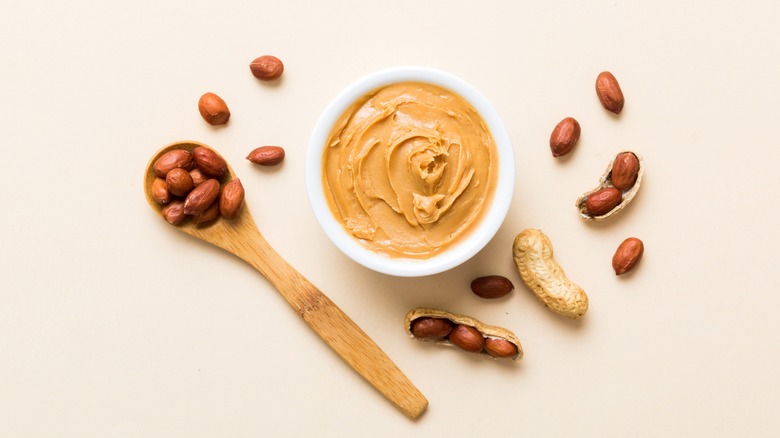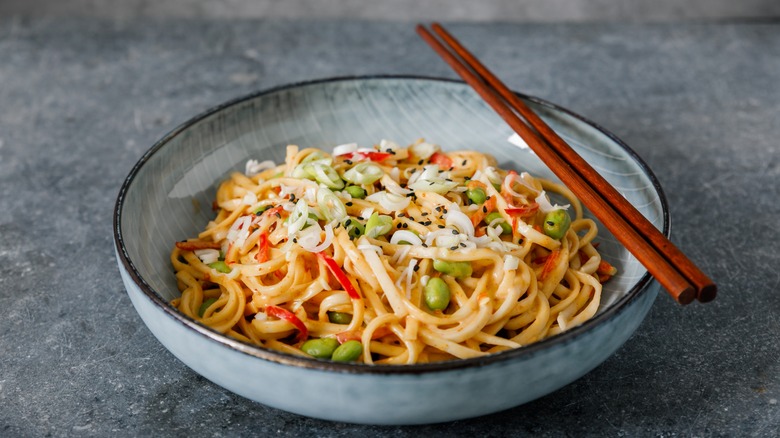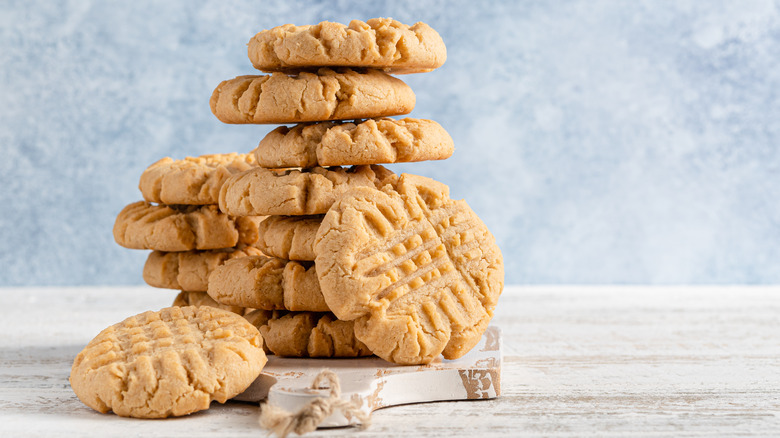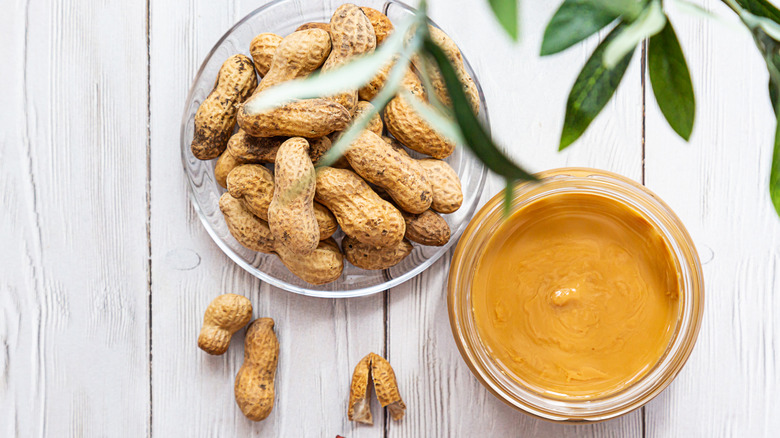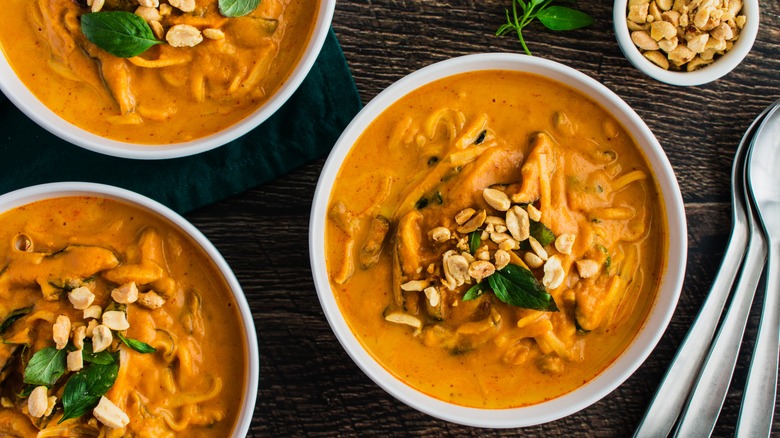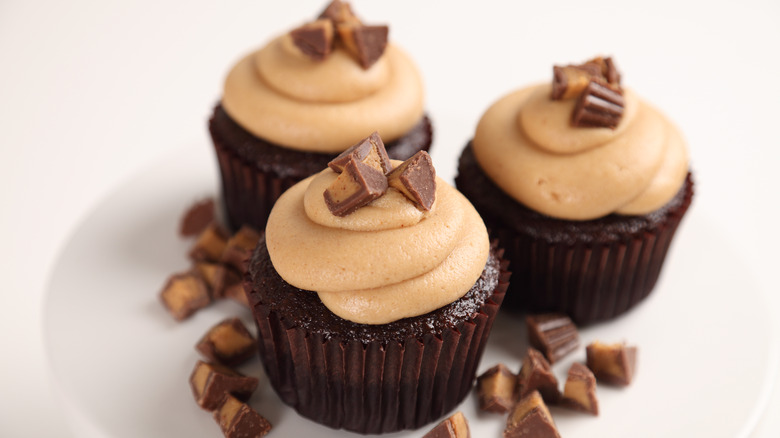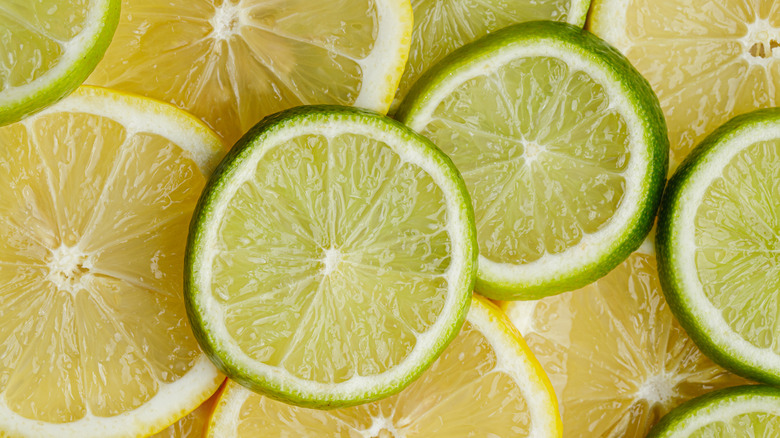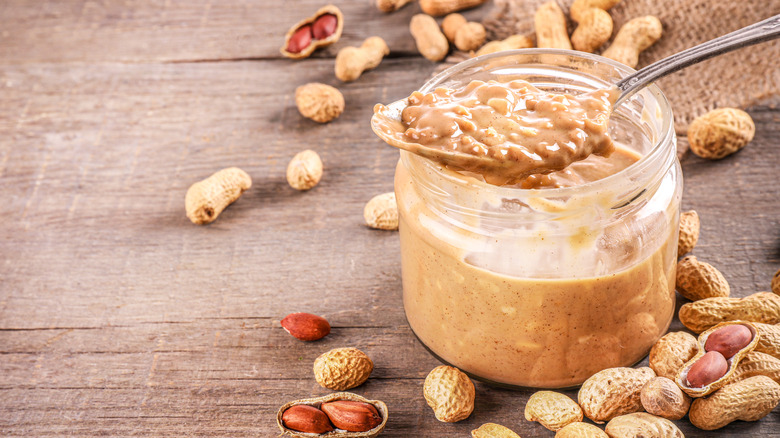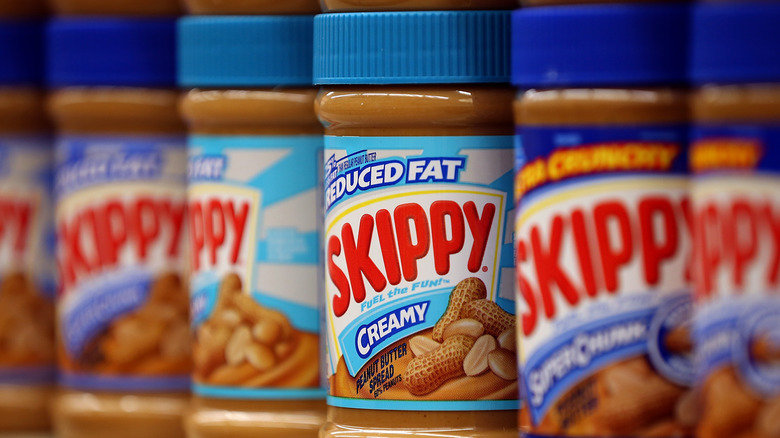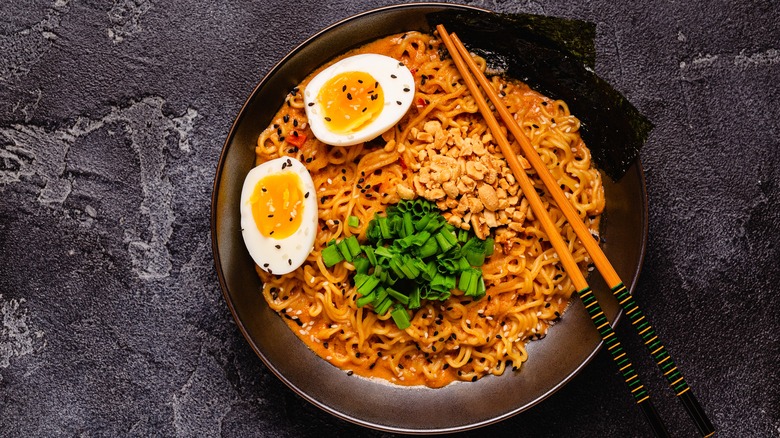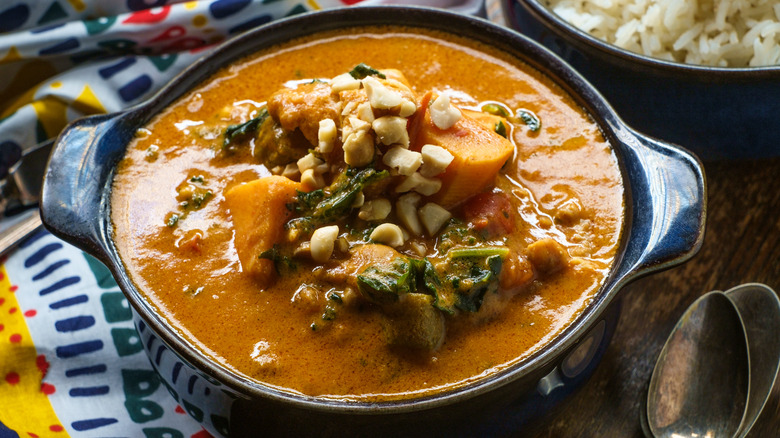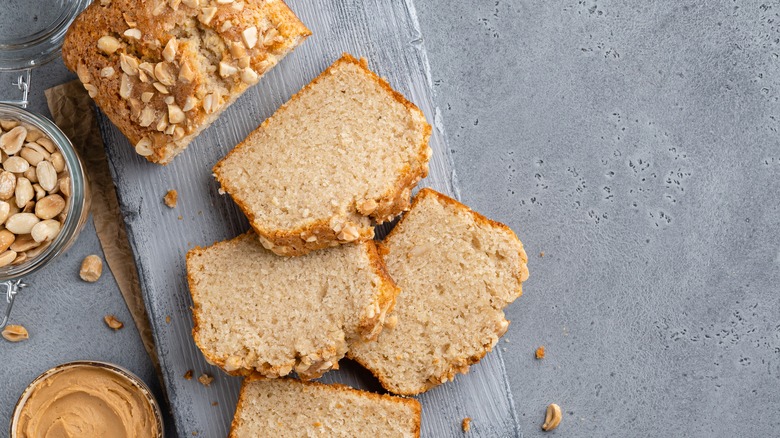Mistakes Everyone Makes When Cooking With Peanut Butter
Peanut butter is an incredibly versatile ingredient. People enjoy it in PBJs or straight out of the jar, but you can also use it in both sweet and savory recipes. Cooking with peanut butter isn't without its pitfalls, however. It's easy to get things wrong and end up with a dish that's claggy and cloying or that just doesn't taste much like peanuts. There are some mistakes everyone makes when cooking with peanut butter. Learning about these frequent errors will help you become better at cooking with this tasty ingredient.
Whether you've only been focusing on sweet recipes to the detriment of its savory uses or you've been pairing it with the wrong ingredients, it's time to turn things around. There's no need to be embarrassed about falling afoul of these missteps. They're common for a reason, after all. We're here to shed some light on them and let you know how to avoid them in the future.
Armed with this knowledge, you're about to improve your cooking skills and make even tastier peanut butter dishes. Whether you're looking to bake the most delicious peanut butter cookies or make a creamy, spicy peanut sauce, avoiding these mistakes will make these dishes your best yet.
Only focusing on sweet recipes
Yes, you can make some incredible sweet recipes using peanut butter, from peanut butter chocolate chip cookies to peanut butter blondies. However, if you only ever make sweet recipes with peanut butter, you're missing out on a whole world of savory goodness. Not sure what to make? We have some ideas!
Thai peanut noodles are always a winner. To make them, cook your favorite noodles and toss them with a sauce made from peanut butter, soy sauce, garlic, ginger, lime juice, and a bit of sesame oil. Add vegetables like bell peppers, carrots, and scallions for crunch. Peanut butter satay skewers are another great choice. Marinate skewered veggies or tofu in a mixture of peanut butter, soy sauce, lime juice, garlic, and a touch of honey. Grill or bake until cooked through.
African peanut stew is a traditional dish from Western Africa, which is an ideal way to use peanut butter in savory cooking. Make a hearty stew with peanut butter, tomatoes, sweet potatoes, chickpeas, and spinach. Add spices like cumin, coriander, and chili powder for depth of flavor. Or what about butternut squash peanut soup? You make it much like any other butternut squash or pumpkin soup, but with a generous scoop of peanut butter and perhaps some spice to balance it out. Of course, these are just a handful of ideas from the countless options available. There are so many amazing savory peanut butter recipes to discover.
Only focusing on savory recipes
Okay, we've just warned against only focusing on sweet recipes, but the opposite is also true. If you only ever cook savory dishes that contain peanut butter, you're not making the most of it. You can also find piles of sweet recipes containing peanut butter that it would be a crime to miss. But where should you start on your journey?
We've already mentioned peanut butter cookies and peanut butter blondies, but they're classics for a reason, so they bear repeating. You can also make delicious brownies with peanut butter swirled in. Peanut butter fudge is simple to make and ridiculously tasty. But these are just the tip of the iceberg. You could also make peanut butter banana bread or other quick breads with peanut butter. There are so many variations on peanut butter pies and peanut butter cupcakes. You can also add peanut butter to muffins and layer cakes. Plus it's great in frosting, too.
Peanut butter is just as versatile in sweet recipes as in savory ones. It pairs with chocolate, banana, vanilla, nuts, and way more. There are many sweet recipes that contain peanut butter, but even more recipes you could successfully adapt to include it.
Not stirring natural peanut butter before use
If you buy natural peanut butter rather than the conventional stuff (like Skippy or Jif), it's important to stir it before you use it in a recipe. Natural peanut butter tends to separate because it lacks the stabilizers and emulsifiers found in commercial peanut butter. The separation is a result of the natural oils in peanuts rising to the top, leaving a denser peanut paste at the bottom. This process is entirely natural and doesn't affect the quality of the peanut butter.
Stirring natural peanut butter is essential before use to recombine the oil and peanuts. If not stirred thoroughly, the top layer will be oilier, and the bottom will be thicker, so you won't get the same results in your recipes as you would using properly combined peanut butter. Stirring ensures a consistent texture throughout the jar. It combines the denser peanut solids with the separated oil, creating a smooth and spoonable consistency. Stirring also helps distribute the oils evenly, ensuring a balanced and flavorful product.
What's more, when the oil separates, the peanut solids at the bottom can become dry and clumpy. Stirring prevents the peanut butter from becoming overly thick and difficult to use, especially as you get closer to the bottom of the jar. You don't want to be left with the last third of your peanut butter overly dry and impossible to incorporate into recipes.
Getting the texture wrong
Every peanut butter lover knows that claggy, stick-to-the-roof-of-the-mouth feeling that you get when you eat too much at once. It's important to use just the right amount in recipes so you don't get the texture wrong. You don't want to be left with a sticky texture in a stew or peanut sauce. It's going to ruin the eating experience — and it will probably taste more like eating straight peanut butter than you'd expect.
On the other hand, peanut butter acts as a thickener in recipes. If you use too little, then you could be left with a watery consistency. This lack of texture is just as bad as a claggy, sticky texture. Plus, it's likely that your dish will end up only tasting very slightly of peanuts, if you can detect the peanutty flavor at all. And then what was the point of even using peanut butter in the first place?
To avoid getting the texture all wrong, stick exactly to any recipe you may be following. However, if you're improvising, it's a little trickier to get it right. Your best bet is to start conservatively and once you've stirred the initial amount through, add more if the dish requires it. Increase the quantity by around a tablespoon at a time until the texture is just right.
Pairing it with the wrong ingredients
Pairing peanut butter with the right ingredients and flavors is crucial in cooking to create delicious, well-balanced dishes. Peanut butter has a distinct nutty taste, and while it can complement a wide range of flavors, some combinations may not work well together.
Peanut butter pairs exceptionally well with sweet and tangy flavors. Ingredients like honey, maple syrup, and fruit preserves can enhance the sweetness, while a touch of acidity from citrus or vinegar can add a delightful tang. The classic combination of chocolate and peanut butter is also a crowd-pleaser. Whether it's in desserts like peanut butter cups or chocolate peanut butter cookies, the rich and slightly bitter notes of chocolate complement the nuttiness of peanut butter.
Warm spices such as cinnamon, nutmeg, and ginger can enhance the depth of flavor in dishes with peanut butter. Other spices and spice blends work with peanut butter, such as garam masala and Thai curry paste. Spicy ingredients like chili peppers, sriracha, or cayenne can create a well-rounded and flavorful dish. Peanut butter blends seamlessly with savory and umami-rich flavors. Incorporating soy sauce, miso, or ingredients like mushrooms can create a savory depth that complements the nutty notes.
But, you should also avoid flavors that don't work well. While lemon and lime in moderation work well with peanut butter, orange and most other citrus fruits don't. Mint is another no-go with peanut butter — need we say more?
Not adding something acidic in savory recipes
Adding acidic ingredients to savory recipes with peanut butter is important. Peanut butter has a naturally rich flavor and creamy texture. Acidic ingredients help cut through this richness, providing a dish that's well-balanced and isn't cloying or sickly sweet. Acidic components also contribute to the complexity of flavors in a dish. They can bring brightness, depth, and a subtle tanginess that complements the nutty, savory notes of peanut butter.
Peanut butter is naturally sweet. And some peanut butter varieties contain added sugar, making them even sweeter. Acidic ingredients help counteract this sweetness, creating a more well-rounded taste. Then, there's the fact that many global cuisines incorporate the combination of nuts and acid. For example, in Thai cuisine, peanut sauces often include lime juice, while West African cuisine combines ground peanuts with tomatoes and other acidic ingredients to make stews like maafe.
So what acidic ingredients should you add? Common options that work well with peanut butter in savory dishes include lemon or lime juice; vinegar, including rice vinegar and apple cider vinegar; tomatoes; and tamarind paste. When using acidic ingredients, it's essential to balance the quantities. Too much acidity to peanut butter will taste overly tart, while too little won't cut through the richness adequately. If you're unsure how much to add, start small and increase as needed. After all, you can always add more of an acidic ingredient, but you can't take it away.
Using crunchy and creamy interchangeably
Using crunchy and creamy peanut butter interchangeably in recipes requires careful consideration, as the texture of these two varieties can significantly impact the finished consistency of the dish. It's important to recognize what each type of peanut butter brings to a recipe. Blindly substituting one for the other may result in unexpected outcomes.
In recipes where you want a smooth and homogeneous texture, such as certain sauces, dressings, or desserts, creamy peanut butter is the best choice. The smoothness of creamy peanut butter ensures a consistent, velvety texture. It works well in applications where you want the peanut flavor without any added crunch.
On the other hand, crunchy peanut butter, with its delightful bits of peanuts, adds a contrasting texture that can be desirable in specific recipes. Dishes like cookies, granola bars, or even certain savory recipes benefit from the added crunch and nuttiness provided by the peanut pieces. The little chunks of peanuts in crunchy peanut butter add bursts of flavor and a satisfying crunch.
Before getting started, you should check the recipe specifications. Some recipes explicitly call for creamy or crunchy peanut butter to achieve the intended texture and flavor profile. Going rogue and using one in place of the other without accounting for these differences might lead to a bit of trial and error. If the recipe emphasizes a silky texture, opt for creamy peanut butter. If a robust and textured profile is what you're after, then crunchy peanut butter might be the better choice.
Using natural and conventional interchangeably
The choice between conventional peanut butter and natural peanut butter can influence the texture and flavor of a dish. Conventional peanut butter often includes added oils and stabilizers to maintain a consistently creamy texture, plus sugar to enhance the flavor. Natural peanut butter, on the other hand, generally contains just peanuts and salt, allowing for a more straightforward flavor profile.
If a recipe specifies one type of peanut butter, using the other may yield slightly different results. When substituting natural peanut butter for conventional or vice versa, there are a few considerations to keep in mind. Firstly, you should think about textural differences. When using natural peanut butter in a recipe that calls for the conventional type, you might notice a denser or drier texture. To combat this, add a little extra oil to the recipe. Conversely, substituting conventional for natural peanut butter might result in a creamier consistency. Where possible, you can very slightly reduce the liquid in the recipe.
Then there's the fact that conventional peanut butter has a notably sweeter taste due to added sugars. If you're substituting natural peanut butter for conventional and want a similar level of sweetness, add extra sugar to achieve the desired taste. Similarly, when using conventional peanut butter in place of natural, you might want to reduce added sugars in the recipe to balance the sweetness. Being aware of the differences between conventional and natural peanut butter allows for more informed substitutions and better finished dishes.
Not using it to upgrade ramen
It's a mistake not to use peanut butter to upgrade your instant ramen. While this student favorite has its place, such as when you need a quick meal after getting home late, it's not always the tastiest. So if you're sick of basic packet ramen, peanut butter can come to the rescue.
Upgrading your instant ramen with peanut butter is super simple. Just toss a tablespoon or two of smooth peanut butter into the simmering broth for a creamy, delicious boost. It takes your usual ramen up a notch, making it extra tasty. You'll still want to use the included seasoning packet, but peanut butter is a welcome extra. Stirring it into the broth gives your ramen a velvety texture and a nutty flavor. The richness of peanut butter blends with the noodle goodness, creating a combo that's both comforting and a bit fancy. Give it a go, and see how a simple dollop of peanut butter can turn your everyday ramen into a tasty treat.
The peanut butter dissolves into the broth, coating each noodle with a creamy layer. The mix of savory broth and peanut flavor makes your ramen taste way better than the basic stuff. You can play around with how much peanut butter you add to get the creaminess just right. This kitchen hack shows how peanut butter can turn an ordinary ramen bowl into something surprisingly delicious.
Making dishes too thick
Are you using peanut butter in recipes, only to find that it makes dishes or batters too thick? In the case of savory dishes, like stews and sauces, this might equate to a finished dish that you could stand a spoon up in, rather than something with a creamy yet still liquidy consistency. Or, in sweet recipes, this might result in batters or doughs that are far thicker than anticipated. Once baked, these might be overly dense, not spreading or rising in the oven as you'd expect them to.
This is a common complaint people make when cooking with peanut butter. The reason for this is simple: you're using too much. It could be down to a bad recipe that hasn't been adequately tested to make sure it works with a range of brands and styles of peanut butter. Another reason could be an error in measuring or scales that are calibrated incorrectly. Or perhaps you just love peanut butter and have been working under the assumption that more is always better.
So how do you make sure your dishes or batters aren't too thick? First, choose a recipe that you trust. Then make sure you weigh or measure your PB correctly. Finally, if you keep ending up with too-thick dishes, try adding a little at a time and stopping when the thickness is to your liking, or if it's a cooked sauce, thin it with a tablespoon or two of water.
Ignoring its potential as a butter substitute
When your butter supply runs low, don't worry — peanut butter can step in as a flavorful substitute in baked goods. So no more last-minute dashes to the store to buy butter, as long as you've got both peanut butter and a neutral-tasting oil (such as canola or grapeseed) in your pantry. To replace butter with peanut butter, begin by mixing up a simple blend: Combine equal parts creamy peanut butter and oil, creating a smooth, workable mixture. This amalgamation serves as a one-to-one swap for butter in various baked goods such as cookies, cakes, brownies, quick breads, or muffins.
By incorporating this peanut butter and oil mixture, you introduce a distinctive nutty essence to your treats. The end result is baked goods that boast not only a rich, moist texture but also a delightful peanutty flavor that sets them apart from the traditional buttery variations. Of course, in some recipes, this nutty twist is an interesting way you'd never thought to use before, like in chocolate peanut butter banana bread, while in others, you might not want a peanut flavor. So keep the final baked good in mind before you implement this butter replacement — some baked goods would be better if you stick to a more neutral flavor.
